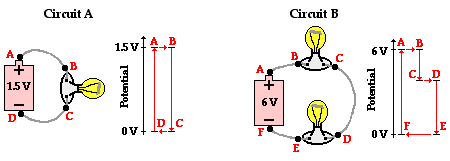

The most elementary concept in electrical science is 'Electric Potential Difference'. If you can grasp this simple concept, most modern electronic science will be easier to understand. That is because potential difference is the causative agent for or currents that drive every electrical device. This article provides a simple explanation of what is electric potential difference.
Electric Potential Energy
Before we can talk about potential difference, one needs to understand what is electric potential and what is an electric field. You must have learned in basic physics courses that charges come in two types: positive charge and negative charge. Like charges repel each other and unlike charges attract each other. They exert this force of attraction of repulsion through an electric field that surrounds the charge. Any charge that comes in vicinity of another charge experiences a force of repulsion or attraction.
Consider a positive test charge placed in an electric field. An attractive force is exerted on it by the electric field center. That is why forcing this charge away from the electric field center requires work to be done, just like work needs to be done to lift anything against the gravitational force. As the charge is forced away, work is done to move it which increases its electric potential energy! More the amount of charge, more will be the work required to force the charge away. Thus electric potential energy of the charge increases as we go away from the charge center of the field. Electric potential is the energy required to transport a unit electrical charge to a specific position in an electrical field. Thus, every point in an electrical field has a different electric potential which is a function of distance from the charge source of the field.
What is Potential Difference?
Now that you understand what electric potential is, understanding electric potential difference is simpler. The electric potential difference between two points, is simply the energy required to transport a unit charge between those two points. It could also be defined as the change in the potential energy that occurs due to transport of a unit charge from one point to the other. Electric current flows from a point of high electric potential to a point which has a lower electric potential. It is just like the behavior of water that always seek its level. Current flows between two points that have a potential difference so as to balance this inequality. Electric potential difference is measured in volts. One volt is defined as one joule per coulomb.
As the current flows between two points, every charge gains energy that is equal to the potential difference between them. Two terminals of any battery have a potential difference between them, which is measured in volts. When you connect any circuit between the two terminals of the battery, charge flows from one terminal to the other to equalize the charge imbalance and continues till the potential difference between them is maintained.
How to Find Potential Difference?
Calculating potential difference is made possible by the Ohm's law. It says that the voltage (potential difference) between two points of a conductor is directly proportional to the current flowing through it as long as the physical properties remain constant. This is expressed in the form of the equation:
V = IR
where V is the potential difference, I is the current flowing and R is the constant proportionality factor which is known as resistance. Thus knowing resistance and current flowing through a conductor, calculating potential difference is possible. There are devices called voltmeters that can be used to measure the electric potential difference between two points. They measure the voltage by detecting the current flowing through that conductor.
Hope, this article has clarified your idea of what potential difference or electrical voltage (in case of static electric field) means. It is this property of flow of electric currents caused by potential difference that powers and drives the modern technological revolution!
No comments:
Post a Comment